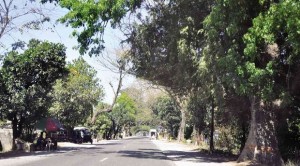No earth-balling machine for trees
URDANETA CITY, Philippines—More than 100 trees, which are supposed to be removed by earth-balling and replanted elsewhere, may end up being cut, after all, in the ongoing widening of MacArthur Highway in the eastern part of Pangasinan province.
This is because the Department of Public Works and Highways (DPWH) has no earth-balling machine, said Jocelyn Sagun, chief of the forest management section of the community environment and natural resources office here.
Earth-balling is the process of extracting a tree, including the soil around it, and transferring it so it can continue to grow.
“There are 107 saplings affected that we required them to earth ball. So, we are still waiting for the DPWH report regarding this,” Sagun said. “Accordingly, they don’t have balling equipment,” she added.
Based on the tree-cutting permit the Department of Environment and Natural Resources (DENR) granted to the DPWH, saplings or trees with trunk diameters of 15 centimeters and below were identified for earth-balling. Ninety nine of these trees are in Villasis town while the rest are in Rosales town.
Narchito Arpilleda, administrative officer of the DPWH district office in Rosales, confirmed that his office had no earth-balling machine.
But he declined to say what happened to the trees that were supposed to be earth balled.
“It’s very difficult to believe that they don’t have earth-balling equipment. That’s the DPWH. They have the resources,” said Dr. Roger Guzman, executive director of the Philippine Federation of Environmental Concern.
Guzman and representatives of Green Convergence, an environmental coalition of 50 organizations, had a dialogue last week with Fernando Estrada, the community environment and natural resources officer here.
Estrada also admitted during the dialogue that not a single tree had been earth balled because the DPWH had no equipment for the job.
A condition in the tree-cutting permit required the DPWH to transplant the trees to areas identified by both the DPWH and DENR. “The transplanted trees shall be maintained by the [DPWH] for a period of at least three years. For every tree that does not survive after six months, the [DPWH] shall [replace it with 100 seedlings],” the permit stated.
Sagun said the DPWH had applied for an extension of its tree-cutting permit but Green Convergence president Angelina Galang had asked the DENR to deny it to save the remaining trees.
“One of the requirements [for the issuance of the tree-cutting permit extension] is their compliance with the conditions [stated] in the first cutting permit. We are waiting for their report,” Sagun said.
She also clarified that when the tree-cutting permit expired, only about 57 percent of the 1,829 trees had been felled, not 70 percent as Estrada had earlier estimated.
“Based on our latest inventory, we still have more than 700 trees. But these have all been girdled. The narra trees, they will survive because it’s only the bark that has been girdled,” Sagun said.
Guzman, a forestry expert, said trees that had been girdled, or stripped of bark around their trunks, might still be saved through proper tree surgery. Gabriel Cardinoza, Inquirer Northern Luzon















